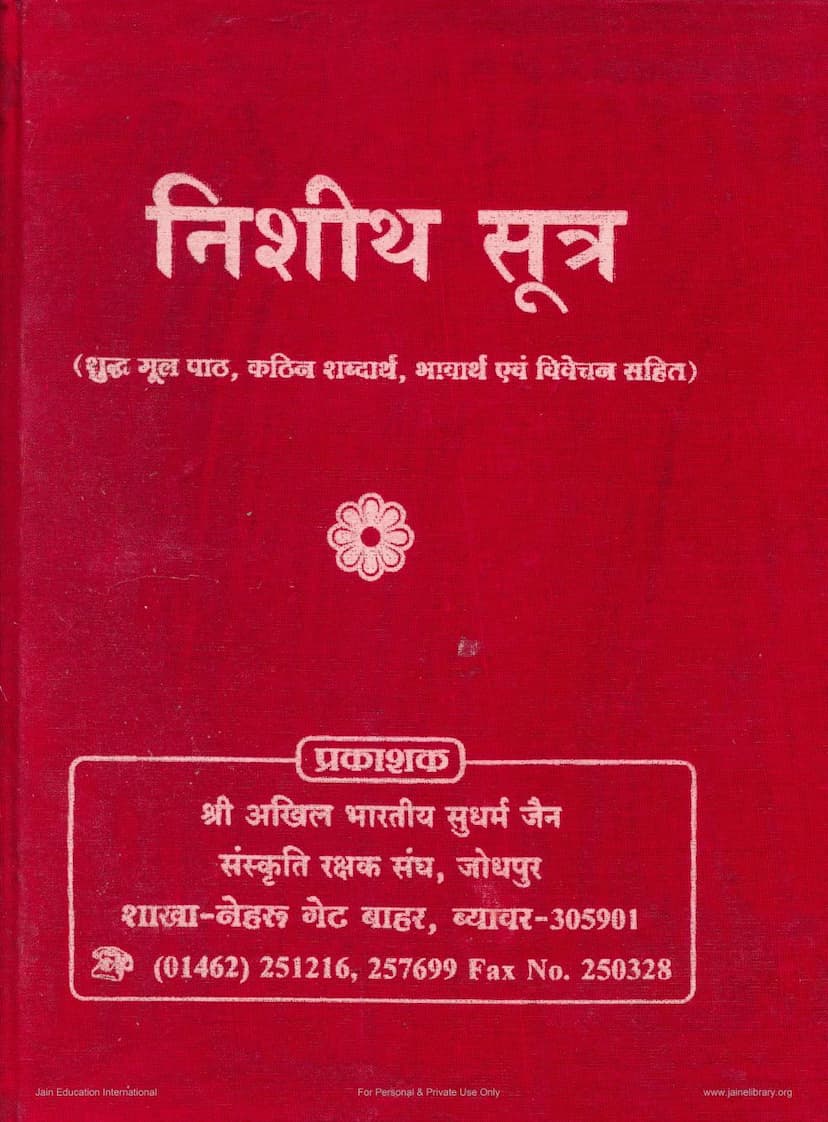Nishith Sutra
Added to library: September 2, 2025

Summary
This is a comprehensive summary of the Nishith Sutra, based on the provided text, focusing on its key themes and structure:
Nishith Sutra: A Summary
The Nishith Sutra is a fundamental text within Jainism, primarily focusing on the conduct and disciplinary rules for fully liberated monks and nuns (Samyami Sadhaks). It delves into the nuances of adhering to vows, identifying potential transgressions, and prescribing atonement (prayschitta) for them. The text emphasizes the importance of pure conduct alongside knowledge, as mere knowledge without proper action is deemed useless, like a "glass eye."
Core Philosophy and Structure:
- Agam Literature as Divine Revelation: The introduction highlights that Jain Agam literature originates from the teachings of Lord Mahavir, embodying the essence of his wisdom. This literature is vast in scope and profound in meaning, covering philosophical thought, and encompassing various branches of knowledge like Dravyanuyoga, Charanannuyoga, Ganitanuyoga, and Dharmakathanuyoga.
- Path to Liberation: The text emphasizes that Jain Agam literature provides pathways for spiritual growth according to an individual's capacity (kshayopasham). While some scriptures are for advanced practitioners, others are accessible to the general seeker, fostering detachment from the world and moving towards spiritual enthusiasm.
- Importance of Conduct: A central theme is the paramount importance of Samayak Acharan (proper conduct). Without it, knowledge is considered futile. The text underscores that the Chaturvidh Sangh (monks, nuns, laymen, and laywomen) must follow specific codes of conduct, sacrifices, and austerities to attain liberation.
- ** उत्सर्ग (Utsarga) and अपवाद (Apavada) Paths:** The Nishith Sutra addresses the potential for even the most dedicated practitioners to falter due to ignorance or weakness. Jain philosophy acknowledges two paths: the Utsarga Marga (the strict, ideal path of adhering to vows without any exception) and the Apavada Marga (the path of exception, taken only under dire circumstances and with stringent atonement). The text details the rules and regulations for utilizing the Apavada Marga and the subsequent purification through prayschitta.
- Atonement (Prayschitta) and Purification: A significant portion of the Nishith Sutra is dedicated to defining and prescribing atonement for various transgressions. This includes detailed classifications of penances (tapas) and specific remedies for different types of faults incurred during spiritual practice. The text lists various levels of penances, such as Laghu Masika, Guru Masika, Laghu Chauthmasika, and Guru Chauthmasika.
- Detailed Prohibitions and Prescriptions: The sutra systematically outlines numerous specific actions that are prohibited for monks and nuns. These cover a wide spectrum of daily life, including:
- Physical Actions: Actions related to bodily hygiene, use of tools, interaction with the environment, and avoiding harm to living beings (even subtle ones).
- Speech and Thought: Prohibitions against harsh speech, falsehood, gossip, and harboring unwholesome thoughts.
- Interactions: Rules regarding interaction with householders, other religious sects, and fellow monastics, particularly regarding the opposite sex.
- Possessions and Resources: Strict guidelines on acquiring, using, and maintaining essential monastic possessions (upadhi).
- Specific Activities: Rules concerning eating, drinking, sleeping arrangements, travelling, and even the management of one's own body and its functions.
- Structure of the Text: The Nishith Sutra is organized into twenty "Uddeshas" (chapters or sections). Each Uddesha addresses a specific category of prohibited actions and their corresponding atonement. The provided text offers a detailed breakdown of the topics covered in each of the first ten Uddeshas, illustrating the meticulousness of the text.
- Types of Violations and Penances: The text classifies offenses into categories like Atikrama, Vyatiskrama, and Atichara. The severity of the penance varies depending on the nature of the offense, the intention behind it, and whether it was committed knowingly or unknowingly. The penances can range from minor observances to more severe austerities.
- Emphasis on Intention and Consciousness: The text often specifies the mental state and consciousness behind an action when determining the fault and its atonement. This shows a nuanced understanding of human fallibility and the importance of mindful conduct.
- A Cautionary and Guiding Text: The Nishith Sutra serves as a crucial guide for monks and nuns, helping them navigate the complexities of ascetic life, maintain purity of conduct, and continue their spiritual journey towards liberation. It also indirectly educates lay followers about the strict discipline and high standards of Jain monasticism.
Key Themes and Concepts Illustrated:
- Ahimsā (Non-violence): The sutra implicitly and explicitly guides against any action that could cause harm to living beings, from the most subtle to the more apparent.
- Brahmacharya (Celibacy): A significant portion addresses the strict adherence to celibacy, covering various actions that could potentially compromise this vow, particularly in relation to interactions with the opposite sex.
- Aparigraha (Non-possession): Rules concerning the limited and specific nature of monastic possessions highlight the principle of non-possession.
- Mindfulness and Vigilance: The text constantly urges monks and nuns to be vigilant and mindful of their actions, thoughts, and speech.
- Purity of Intention: The emphasis on intention in determining fault indicates that actions driven by negative intentions are more severely judged.
- The Role of Acharyas and Gurus: The text implicitly recognizes the authority of senior monks (Ganis, Acharyas, Upadhyayas) in guiding the monastic community and determining appropriate actions and penances.
In essence, the Nishith Sutra is a detailed and practical manual for the Jain monastic order, ensuring the rigorous observance of vows and providing a framework for spiritual discipline and purification, ultimately aimed at achieving liberation.